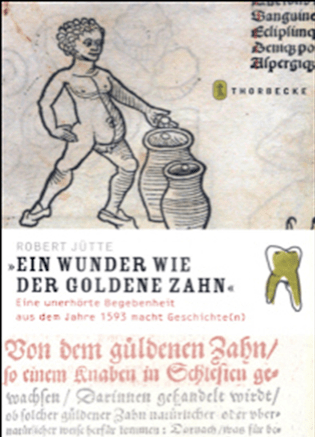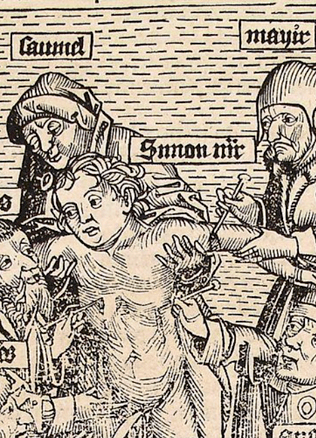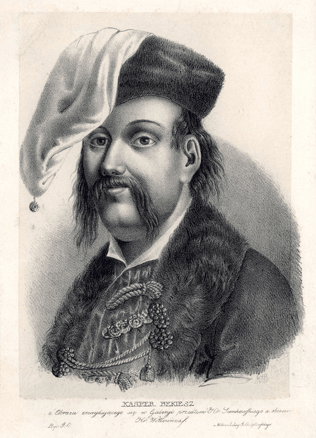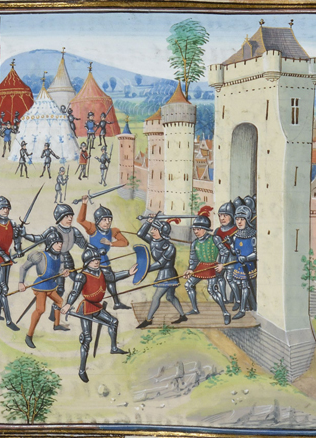Algirdas – “An Orthodox Believer”
Today the historiographical myth about Algirdas being an Orthodox believer has died out, but one can find its remnants among texts by propagandists from the Russian Empire. During the first half of the 20th century, this myth was widespread among Russian researchers and researchers of other countries under Russian influence. At the time it was almost an “obvious truth.” It was said that the pagan Lithuanians (“barbarians”) had experienced the influence of Kiev Rus’ “civilization,” as the entire Lithuanian state became almost Russified. It was only the ill-fated conversion to Catholicism by Jagiełło that stopped the “natural” development of Lithuania on a path of Russian culture. In this context, the myth about Algirdas the Orthodox believer arose not as a research issue of history at the time, but as the fruit of imperial propaganda. This did not appear in a vacuum, as some sourced do mention Algirdas being an Orthodox believer. One needs to look deeper, evaluate their reliability, and compare them with other sources that show that Algirdas was a pagan until his death.
The earliest written sources about Algirdas’ faith come from three different cultural regions. This ruler of Lithuania was mentioned in the chronicles of the Teutonic Order, in Rus’ chronicles, and in some monuments of Byzantine written works. A part of the latter appeared still while Algirdas was alive.
The cruel “fire worshipper”
Do You Know?
In the Encomium for the Three Martyrs of Vilnius written by Michael Balsamon in the 14th century, Algirdas is talked about in the text like a pagan: “And that this godless person did not spare us their remains, he has no qualms about honouring their common customs and allowed them to establish a temple in their place of death – does this not surpass all the feats celebrated by monuments and memorials?” However, they were tortured on Algirdas’ orders for their Christian customs, such as growing a beard and not eating meat.
Nikephoros Gregoras’ Roman History (which was finished around 1360) is the earliest source that talks about Algirdas, though his name is not mentioned. In this work, Algirdas is depicted as a worshipper of the sun and fire, who is just starting to think about being baptised. According to Gregoras, Algirdas hasn’t been baptised only because Constantinople Patriarch Philotheus I did not satisfy his wish to ordain Roman, Algirdas’ candidate for metropolitan of Kiev and all of the Rus’. Algirdas as a pagan became even more pronounced in letters written by Patriarch Philotheus I in 1370 to Rus’ dukes, that had been separated from the Church during the war that was raging between Lithuania and Moscow, because “they became involved with that godless Algirdas, who, having attacked the Grand Duchy, killed and destroyed a number of Christians.” In 1380 in a letter by Patriarch Nilus, Algirdas is simply called the “the fire-worshipping Lithuanian duke.” In the Encomium for the Three Martyrs of Vilnius written in Greek by Michael Balsamon in the 14th century, Algirdas is talked about in the text like a pagan: “And that this godless person did not spare us their remains, he has no qualms about honouring their common customs and allowed them to establish a temple in their place of death – does this not surpass all the feats celebrated by monuments and memorials?” Fourteenth century Byzantine sources show that Algirdas was a pagan.
A godless teetotaller
That was the same conclusion that comes from Rus’ chronicles from the 14th and 15th century. In the Novgorod Fourth Chronicle it is written how the inhabitants of Pskov cooperated with Algirdas, who defending them from the Livonian Germans that had attacked their lands. However joint actions did not work out. Though Pskov “had great difficulties with Algirdas,” they still wanted him to become baptised and become their duke. This offer was not suitable for Algirdas, and “he refused to become baptised and be a duke in Pskov.” He agreed to have his son Andrei become the duke of Pskov, who became baptised to this end. This information shows that it is not possible to believe the stories that state that Algirdas had to be an Orthodox believer to be the duke of Vitebsk. If he had already been an Orthodox believer, then Pskov would not have had to take measures to have Algirdas baptised.
The most vivid information concerning Algirdas’ death was included in the Trinity Chronicle, the compilation of which ended in 1408. It is thought that the view of Cyprian, Metropolitan of Kiev and All Rus’, who knew Algirdas, is reflected in the chronicle. The descriptions like “evil in his faith, godless and unclean” do not allow us to believe that the text is talking about a baptised ruler. However, the paganism of Algirdas was not a barrier for the chronicler to depict him as a good example for Russian dukes: “Olgerd surpassed all his brothers in power and dignity, because he did not drink beer nor mead nor wine nor sour kvass.“
Information given by Livonian Order chronicler Hermann de Wartberge concerning the 1377 funeral of Algirdas gives a strong argument in favour of Algirdas being a pagan: “The supreme Lithuanian ruler Algirdas died. The funeral was very solemn, according to their customs, various objects and eighteen horses were burned.”
In summarising the information of the 14th and 15th century, there is no basis to believe that Algirdas was an Orthodox believer. He remained a pagan his whole life. The versions about the Orthodox baptism of Algirdas began to appear in chronicles of the 16th century, which is why they cannot be reliable. They are interesting as signs as to how myths appear.
The chroniclers that “baptised” Algirdas
It’s written in the Bychowiec Chronicle that “then Prince Olgierd took to wife Princess Uliana of Vitebsk, for whom Prince Olgierd was baptized in the Russian faith, while all the Lithuanian nobles remained pagans. And Grand Prince Olgierd did not force them and did not convert them to his faith. And the Roman faith again was not to be found in Lithuania, only the Russian (faith) was among (the Lithuanians).“ Here Algirdas second wife is confused with his first wife, the princess of Vitebsk, who it is thought was named Maria (or perhaps Ona). The “fact” that appeared concerning Algirdas’ baptism was determined by the fact that Algirdas was the duke of Vitebsk, and the mentioning that at the time in Lithuania was a “Russian faith” should be understood in a context that would bring out the contributions of Petras Goštautas, the assumed vicegerent of Algirdas in Vilnius, who founded the first Franciscan monastery in Lithuania. “This Petras Goštautas was the first to accept the Roman faith and brought it to Lithuania.” A theory mentioned once gained currency and was repeated by Maciej Stryjkowski and Albert Wijuk Kojałowicz.
We also meet Algirdas the Orthodox believer in 16th century chronicles written in the Russian state. In these works, attempts are made to show the alleged low birth of Lithuanian rulers, and their subordination to Muscovite rulers. These are politically motivated texts that express ideological claims on GDL lands. In this context, knowledge about Algirdas’ baptism in his deathbed were to be able to illustrate the right of Russian Orthodoxy for Lithuanian lands. This is why in the Muscovite tradition of chronicles, Algirdas’ image changed: during a span of one hundred years, he changed from a cruel pagan to a Lithuanian ruler who died surrounded by monks. Later the same idea was repeated by those writing Imperial Russian propaganda, for whom a critical overview of history was often too hard of a nut to crack.
Literature: R. Mažeika, „Lietuvos didžiojo kunigaikščio Algirdo laikysena krikščionybės atžvilgiu“, in: Lietuvių katalikų mokslo akademijos Suvažiavimo darbai, t. 13, 1991, p. 205–219.
Darius Baronas



